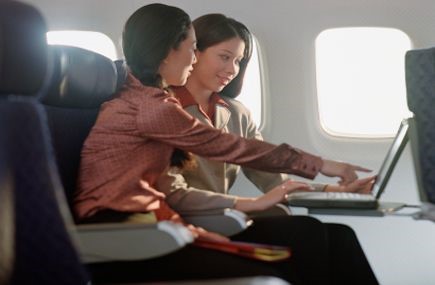by Fred Gebhart
January 07, 2014
In the world of business travel, 2014 is shaping up to look a lot like 2013, only more so – more focus on mobile, more focus on technology, more focus on the traveler and more focus on finding new ways to manage travel.
Travel Market Report spoke with leaders in business travel to find out their expectations for the New Year. Here’s what they told us.
Buckner: Integrated solutions are key
Mobile technology changed the landscape of business travel in 2013 and will continue to do so in 2014, said Lisa Buckner, president of CTS in Minnetonka, Minn.
Today’s travelers can do just about anything on their smartphones that a good business travel agent can do at their desk, and that’s altering the game in several ways.
“We have to make sure the information relating to a trip is seamless for the traveler. The traveler wants an integrated solution for the travel experience,” Buckner said.
“Providing that centers around working with your suppliers as true partners. They are not just suppliers any more. They are customers, working with you to service a mutual customer – the traveler.
“There can’t be just one answer, any more than there is just one traveler,” Buckner said. “You have to have the technology and you have to have the information, and you have to blend the two in a highly intelligent fashion. You have to make sure your partners are as invested in the traveler as you are.”
Eastman: Consumerization will rule
The consumerization forces that transformed leisure travel will reshape business travel in 2014. With the traveler increasingly at the center of the universe, travel management systems that can’t – or don’t – recognize the primacy of the traveler will be ignored, said Richard Eastman, president of The Eastman Group.
“Business, including travel, has been built around a hierarchical structure where products, airplane seats, hotel rooms, rental cars, flowed down to consumers. That model is changing.
“As information moves from the distribution channel-mode – from pricy and controlled by airlines and GDSs to virtually free and ubiquitous mediums – the structure of travel management and the tools that accompany that management must change,” Eastman said.
The process is likely to involve fits and starts.
“Travel is a very established and mature industry, and change does not come easily to mature industries. Mixing, matching and balancing the old while meeting the needs of new technologies, new managers and new solution providers will be the No. 1 challenge in 2014,” Eastman said.
Rose: Get ahead of the curve
In 2014, travel managers can’t afford to wait for policy to catch up with travelers’ use of mobile, suggested Norm Rose, president of Travel Tech Consulting.
“Travelers are driving the technology change in the industry. TMCs and travel managers need to be proactive in providing in-destination support for travelers via mobile devices through the entire trip.
“Travel managers must be proactive in providing solutions that assist travelers during disruptions. These tools need to automatically recommend alternative flights and provide approved hotels in the event overnight accommodation is needed.”
Hilton: Get smarter
TMCs already have the information they need to personalize the travel experience; what they need to do is use it, said Mike Hilton, executive vice president and general manager of Concur Travel and Expense.
“The agency knows what I do, knows what my colleagues do, has all of our accumulated travel history. The travel experience can get a lot smarter just by leveraging information we already have to make better recommendations.
“That will happen in part by opening up the business travel ecosystem,” Hilton said.
“There is a huge opportunity by taking this corporate travel data that has traditionally been locked up in a GDS or an agency and putting it into a cloud environment where third parties can add value, add services, add employee enrichment.”
Wartgow: Think door-to-door
Travelers don’t look at individual elements of a trip – air, car, hotel, meals – as much as they look at the entire experience. TMCs and travel managers must adopt that same door-to-door mindset, said Joel Wartgow, senior director, the Americas, for CWT Solutions Group.
“Travel managers have an opportunity to get their arms around all aspects of a trip, not just air, hotel and rental car. How do they leave their house? How do they get to their destination at the other end? Where do they eat? How do they keep in touch?
“Give a traveler information on all of their travel aspects – from when they walk out their door until they walk back in after the trip. Give them an environment where they can book all of that in one interface.
“It improves their experience and it helps prevent them from having to search for information through alternative channels. There is no shortage of opportunities,” Wartgow said.
Brindley: Hotel programs reconsidered
Chain-wide agreements and price-assurance technology are transforming hotel programs, said Bob Brindley, vice president of Advito, the travel research arm of BCD Travel. Hotel programs are becoming as complex as air programs.
“Price-assurance technology allows the buyer to ensure that the traveler is booking the best rate and then getting the best rate available the day of the stay. Unlike airfares, most corporate bookings are fully refundable. That gives you a four-pronged strategy to maximize your buying power.”
Brindley outlined the four prongs as follows: “You have preferred rates at your top-level properties. Supporting that are chain-wide agreements that cover locations not in your primary preferred program.
“Next is a spot-buy program to take advantage of yield management decisions or promotional pricing. And you have price-assurance technology tying it all together and making sure you get the absolute best price available when your traveler checks in.
“You want to make sure yield management works in your favor and not just in the supplier’s favor.”
Original article:
Click here to view the original article.


